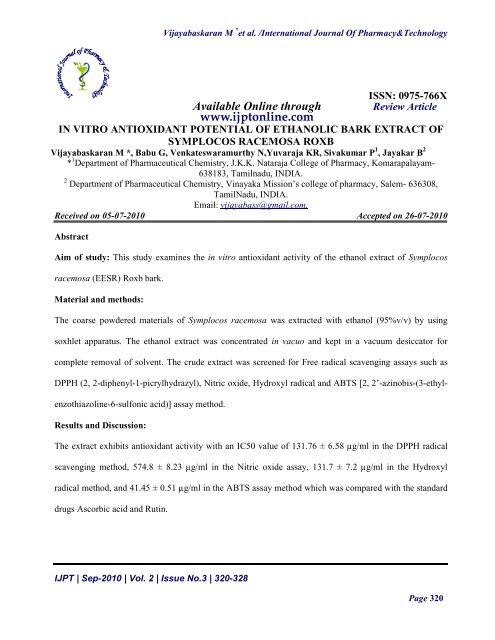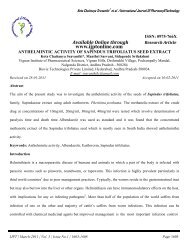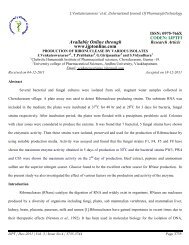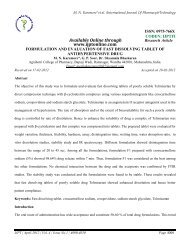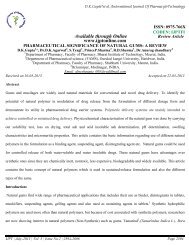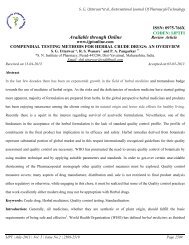Available Online through - International Journal of Pharmacy and ...
Available Online through - International Journal of Pharmacy and ...
Available Online through - International Journal of Pharmacy and ...
Create successful ePaper yourself
Turn your PDF publications into a flip-book with our unique Google optimized e-Paper software.
Vijayabaskaran M * et al. /<strong>International</strong> <strong>Journal</strong> Of <strong>Pharmacy</strong>&TechnologyISSN: 0975-766X<strong>Available</strong> <strong>Online</strong> <strong>through</strong> Review Articlewww.ijptonline.comIN VITRO ANTIOXIDANT POTENTIAL OF ETHANOLIC BARK EXTRACT OFSYMPLOCOS RACEMOSA ROXBVijayabaskaran M *, Babu G, Venkateswaramurthy N,Yuvaraja KR, Sivakumar P 1 , Jayakar B 2* 1 Department <strong>of</strong> Pharmaceutical Chemistry, J.K.K. Nataraja College <strong>of</strong> <strong>Pharmacy</strong>, Komarapalayam-638183, Tamilnadu, INDIA.2 Department <strong>of</strong> Pharmaceutical Chemistry, Vinayaka Mission’s college <strong>of</strong> pharmacy, Salem- 636308,TamilNadu, INDIA.Email: vijayabass@gmail.com.Received on 05-07-2010 Accepted on 26-07-2010AbstractAim <strong>of</strong> study: This study examines the in vitro antioxidant activity <strong>of</strong> the ethanol extract <strong>of</strong> Symplocosracemosa (EESR) Roxb bark.Material <strong>and</strong> methods:The coarse powdered materials <strong>of</strong> Symplocos racemosa was extracted with ethanol (95%v/v) by usingsoxhlet apparatus. The ethanol extract was concentrated in vacuo <strong>and</strong> kept in a vacuum desiccator forcomplete removal <strong>of</strong> solvent. The crude extract was screened for Free radical scavenging assays such asDPPH (2, 2-diphenyl-1-picrylhydrazyl), Nitric oxide, Hydroxyl radical <strong>and</strong> ABTS [2, 2’-azinobis-(3-ethylenzothiazoline-6-sulfonicacid)] assay method.Results <strong>and</strong> Discussion:The extract exhibits antioxidant activity with an IC50 value <strong>of</strong> 131.76 ± 6.58 µg/ml in the DPPH radicalscavenging method, 574.8 ± 8.23 µg/ml in the Nitric oxide assay, 131.7 ± 7.2 µg/ml in the Hydroxylradical method, <strong>and</strong> 41.45 ± 0.51 µg/ml in the ABTS assay method which was compared with the st<strong>and</strong>arddrugs Ascorbic acid <strong>and</strong> Rutin.IJPT | Sep-2010 | Vol. 2 | Issue No.3 | 320-328Page 320
Vijayabaskaran M * et al. /<strong>International</strong> <strong>Journal</strong> Of <strong>Pharmacy</strong>&Technologydrugs/formulations for the prevention <strong>and</strong> treatment <strong>of</strong> complex diseases like atherosclerosis; stroke,diabetes, Alzheimer's disease, <strong>and</strong> cancer have appeared during the last 3 decades (7, 8).This has attracted a great deal <strong>of</strong> research interest in natural antioxidants. The present study wastaken up on the medicinal plant namely Symplocos racemosa also called as Lodhra belongs to the familySymplocaceae (9). The plant is small evergreen tree with stems upto 6m height <strong>and</strong> 15 cm diameter. Barkdark grey, rough. Blaze 7.5-13 mm, shortly fibrous, pale yellow, finely mottled with pale brown. It isdistributed <strong>through</strong>out India. Literature review reveals that the bark contains carbohydrates, glycosides,alkaloids, triterpenoids, sterols, saponnins, phenolic compounds <strong>and</strong> hydrolysable tannins, etc., (11, 12).Traditionally it is used for treatment <strong>of</strong> diarrhoea, dysentry, liver complaints <strong>and</strong> dropsy. It is also used asantioxytocic, amoebicide, anticancer, conjunctivitis <strong>and</strong> ophthalmia, decoction <strong>of</strong> bark is used to treatbleeding gums, menorrhagia <strong>and</strong> other uterine disorders (13, 14). Here the bark is screened for In vitroantioxidant activity study using DPPH, Nitric oxide, Hydroxyl radical <strong>and</strong> ABTS assay methods. Ascorbicacid <strong>and</strong> Rutin used as a st<strong>and</strong>ard.2. MATERIALS AND METHODS2.1 Collection <strong>of</strong> plant Material <strong>and</strong> ExtractionThe plant Symplocos racemosa (Family: Symplocaceae) was collected from Kolli Hills atNamakkal District, Tamilnadu, India. Further it was authenticated by the taxonomist Dr.V.Sathyanathan,Epoch Pharma <strong>and</strong> Research Labs Pvt. Ltd. Chennai, <strong>and</strong> its voucher specimen was deposited in theHerbarium for further reference. After due authentication the barks were dried in shade <strong>and</strong> powdered toobtain coarse powder. The coarse powder material (250g) was extracted with ethanol (95%v/v) by usingsoxhlet apparatus. The ethanol extract was concentrated in vacuo <strong>and</strong> kept in a vacuum desiccator forcomplete removal <strong>of</strong> solvent. The yield was 9.3% w/w with respect to dried powder (15).IJPT | Sep-2010 | Vol. 2 | Issue No.3 | 320-328Page 322
Vijayabaskaran M * et al. /<strong>International</strong> <strong>Journal</strong> Of <strong>Pharmacy</strong>&Technology2.2 ChemicalsDPPH (2,2-diphenyl-1-picrylhydrazyl) [Sigma Chemicals Co], Methanol, DMSO (DimethylSulphoxide), Sodium nitroprusside, Naphthyl ethylene diamine dihydrochloride, Sulphanilic acid,Potassium persulphate, Ferric chloride, Hydrogen peroxide, Thiobarbituric acid, Trichloro acetic acid,Ascorbic acid <strong>and</strong> Rutin were purchased from Merck India Ltd.3. PHARMACOLOGICAL SCREENING3.1 Antioxidant AssayThe antioxidant activity <strong>of</strong> plant extract was determined by different in vitro methods such asDPPH free radical scavenging assay, Nitric oxide, Hydroxyl radical <strong>and</strong> ABTS assay method. All theassays were carried out in triplicate <strong>and</strong> average values were considered.3.2 DPPH AssayThe free radical scavenging capacity <strong>of</strong> Ethanolic extract <strong>of</strong> Symplocos racemosa (EESR) wasdetermined using DPPH method. DPPH solution (0.004% w/v) was prepared in 95% ethanol. EESR wasmixed with 95% ethanol to prepare the stock solution (10mg/100ml). The concentration <strong>of</strong> this solutionwas 10 mg /100 ml or 100µg/ml. From stock solution 2ml, 4ml, 6ml, 8ml & 10ml <strong>of</strong> this solution weretaken in five test tubes & by serial dilution with same solvent were made the final volume <strong>of</strong> each test tubeup to 10 ml whose concentration was then 20µg/ml, 40µg/ml, 60µg/ml, 80µg/ml &100µg/ml respectively.Freshly prepared DPPH solution (0.004% w/v) was added in each <strong>of</strong> these test tubes containing EESR (20µg/ml, 40µg/ml, 60µg/ml, 80µg/ml, 100µg/ml) <strong>and</strong> after 10 min, the absorbance was taken at 517 nm usinga spectrophotometer (HACH 4000 DU UV– Visible spectrophotometer). Ascorbic acid was used as areference st<strong>and</strong>ard <strong>and</strong> dissolved in distilled water to make the stock solution with the same concentration(10 mg/100ml or 100µg/ml) <strong>of</strong> EESR. Control sample was prepared which contains the same volumewithout any extract <strong>and</strong> reference ascorbic acid. 95% ethanol was used as blank. % scavenging <strong>of</strong> theDPPH free radical was measured using the following equation (16-18).IJPT | Sep-2010 | Vol. 2 | Issue No.3 | 320-328Page 323
Vijayabaskaran M * et al. /<strong>International</strong> <strong>Journal</strong> Of <strong>Pharmacy</strong>&TechnologyAbsorbance <strong>of</strong> control - Absorbance <strong>of</strong> test Sample% DPPH radical-scavenging = ×100Absorbance <strong>of</strong> control3.3 Nitric oxide scavenging activityNitric oxide scavenging was carried out using the alkaline Dimethyl Sulfoxide (DMSO) method(18). Solid potassium superoxide was allowed to st<strong>and</strong> in contact with dry DMSO for at least 24 hrs <strong>and</strong>the solution was filtered immediately before use; the filtrate (200 µl) was added to 2.8 ml <strong>of</strong> an aqueoussolution containing nitroblue tetrazolium (56 µM), EDTA (10 µM) <strong>and</strong> potassium phosphate buffer (10µM, pH 7.4). Test solutions at different concentrations (5-100 µg/ml) were added <strong>and</strong> absorbances wererecorded at 540 nm against the control.3.4 Hydroxyl radical scavenging activityThe assay was performed by adding 0.1 ml <strong>of</strong> EDTA, 0.01 ml <strong>of</strong> ferric chloride, 0.1 ml <strong>of</strong> hydrogenperoxide, 0.36 ml <strong>of</strong> deoxyribose, 1.0 ml <strong>of</strong> test solutions (5-100 µg/ml) in distilled water, 0.33 ml <strong>of</strong>phosphate buffer (50 mM, pH 7.4) <strong>and</strong> 0.1 ml <strong>of</strong> ascorbic acid in sequence. The mixture was thenincubated at 37 0 C for 1 hr <strong>and</strong> 1.0 ml portion <strong>of</strong> the incubated mixture was mixed with 10 % TCA <strong>and</strong> 1.0ml <strong>of</strong> 0.5 % TBA to develop the pink chromogen <strong>and</strong> measured at 532 nm (19).3.5 ABTS radical cation assayThe assay measures ABTS.+ radical cation formation induced by metmyoglobin <strong>and</strong> hydrogenperoxide. Trolox [6-Hydroxy-2,5,7,8- tetramethylchroman-2-carboxylic acid], a water soluble vitamin Eanalog, serves as a positive control inhibiting the formation <strong>of</strong> the radical cation in a dose dependentmanner. The antioxidant activity in biological fluids, cells, tissues, <strong>and</strong> natural extracts can be normalizedto equivalent Trolox units to quantify the composite antioxidant activity present. ABTS was dissolved inwater to a 7 mM concentration. ABTS radical cation (ABTS•1) was produced by reacting ABTS stocksolution with 2.45 mM potassium persulfate (final concentration) <strong>and</strong> allowing the mixture to st<strong>and</strong> in theIJPT | Sep-2010 | Vol. 2 | Issue No.3 | 320-328Page 324
Vijayabaskaran M * et al. /<strong>International</strong> <strong>Journal</strong> Of <strong>Pharmacy</strong>&Technologydark at room temperature for 12-16 h before use. Because ABTS <strong>and</strong> potassium persulfate reactstoichiometrically at a ratio <strong>of</strong> 1:0.5, this will result in incomplete oxidation <strong>of</strong> the ABTS. Oxidation <strong>of</strong> theABTS commenced immediately, but the absorbance was not maximal <strong>and</strong> stable until more than 6 h hadelapsed. The radical was stable in this form for more than two days when stored in the dark at roomtemperature. For the study <strong>of</strong> phenolic compounds <strong>and</strong> food extracts, the ABTS•1 solution was diluted withethanol <strong>and</strong> for plasma antioxidants with PBS, pH 7.4, to an absorbance <strong>of</strong> 0.70 (60.02) at 734 nm <strong>and</strong>equilibrated at 30°C. Stock solutions <strong>of</strong> phenolics in ethanol, carotenoids in dichloromethane <strong>and</strong> plasmaantioxidants in water were diluted such that, after introduction <strong>of</strong> a 10ml aliquot <strong>of</strong> each dilution into theassay, they produced between 20%–80% inhibition <strong>of</strong> the blank absorbance. After addition <strong>of</strong> 1.0 ml <strong>of</strong>diluted ABTS•1 solution to 10 ml <strong>of</strong> antioxidant compounds or Trolox st<strong>and</strong>ards (final concentration 0-15mM) in ethanol or PBS the absorbance reading was taken at 30°C exactly 1 min after initial mixing <strong>and</strong> upto 6 min. Appropriate solvent blanks were run in each assay. All determinations were carried out at leastthree times, <strong>and</strong> in triplicate, on each occasion <strong>and</strong> at each separate concentration <strong>of</strong> the st<strong>and</strong>ard <strong>and</strong>samples (20).4. RESULTS AND DISCUSSIONCrude ethanolic extract may contain thous<strong>and</strong>s <strong>of</strong> phytochemical constituents. Concentration <strong>of</strong> sample atwhich the inhibition percentage reaches 50% is the IC 50 value. IC 50 value is negatively related to theantioxidant activity, as it expresses the amount <strong>of</strong> antioxidant needed to decrease the radical concentrationby 50%. The lower the IC 50 value, the higher is the antioxidant activity <strong>of</strong> the tested sample. The IC 50values <strong>of</strong> EESR for DPPH radical, Nitric Oxide radical, hydroxyl radical, ABTS radical Scavengingactivities are summarized in Table 1.IJPT | Sep-2010 | Vol. 2 | Issue No.3 | 320-328Page 325
Table 1 Free radical scavenging activity <strong>of</strong> EESRVijayabaskaran M * et al. /<strong>International</strong> <strong>Journal</strong> Of <strong>Pharmacy</strong>&TechnologyExtract /St<strong>and</strong>ardsIC 50 values ± SEM µg/ml* by methodsDPPH Nitric oxide ABTS H 2 O 2Ascorbic acid 2.69 ±0.05 ------- 11.25 ±0.49 187.33 ±1.93Rutin ------- 65.44 ±2.56 0.51 ± 0.01 36.66 ± 0.22EESR 131.76 ±6.58 574.8 ±8.23 41.45 ±0.51 131.7 ±7.20*Average <strong>of</strong> triplicate determinations. Values were mean ± S.E.MEESR exhibited potent ABTS radical scavenging activity with IC 50 value 41.45±0.51µg/ml which issignificantly lower than those <strong>of</strong> the st<strong>and</strong>ard Ascorbic acid <strong>and</strong> Rutin. The IC 50 value <strong>of</strong> extract for DPPH,Nitric Oxide radical, Hydroxyl radical was 131.76±6.58, 574±8.23 <strong>and</strong> 131.7±7.20µg/ml respectively,which were significantly higher than those <strong>of</strong> the st<strong>and</strong>ard Ascorbic acid <strong>and</strong> Rutin. According to theresults in table 1, the EESR possessed moderate antioxidant activity.5. CONCLUSIONThe results <strong>of</strong> the study indicated that the Ethanolic extract <strong>of</strong> Symplocos racemosa (EESR) showed potentantioxidant activity in ABTS assay method than other methods <strong>and</strong> can be used as accessible source <strong>of</strong>natural antioxidants <strong>and</strong> a possible food supplement.6. REFERENCES1. Saha MN, Alam MA, Aktar R <strong>and</strong> Jahangir R In vitro free radical scavenging activity <strong>of</strong> Ixoracoccinea L. Bangladesh J Pharmacol 2008,3, pp 90-96.2. Polterait O Antioxidants <strong>and</strong> free radical Scavengers <strong>of</strong> Natural origin. Current Org. Chem 1997, 1, pp415-440.IJPT | Sep-2010 | Vol. 2 | Issue No.3 | 320-328Page 326
Vijayabaskaran M * et al. /<strong>International</strong> <strong>Journal</strong> Of <strong>Pharmacy</strong>&Technology3. Prior RL Fruit <strong>and</strong> vegetables in the prevention <strong>of</strong> cellular oxidative damage. Am J Clin Nutr 2003, 78,pp 570S-578S.4. Makari HK, Haraprasad N, Patil HS, Ravikumar In Vitro Antioxidant Activity <strong>of</strong> the Hexane <strong>and</strong>Methanolic Extracts <strong>of</strong> Cordia Wallichii <strong>and</strong> Celastrus Paniculata. The Internet J. Aesthetic <strong>and</strong>Antiaging Medicine 2008, 1, pp 1-10.5. Augustin S, Claudine M, Christine M, Christian R Dietarypolyphenols <strong>and</strong> the prevention <strong>of</strong> diseases.Crit Rev Food Sci 2005, 45, pp 287-306.6. Lu Y, Foo Y Antioxidant activities <strong>of</strong> Polyphenols from sage (Salvia <strong>of</strong>ficinalis). Food Chem 2001, 75,pp 197-202.7. Hennebelle T, Sahpaz S, Joseph H, Bailleul F Phenolics <strong>and</strong> iridoids <strong>of</strong> Lippia alba.Nat Prod Commun2006, 1, pp 727-730.8. Trease GE, Evans WC, Pharmacognosy: A Physicians's Guide to Herbal Medicine.15th ed. Edinburgh,UK,Saunders WB, 2005, pp 125-135.9. Chopra RN, Nayar SL, Chopra IC. Glossary <strong>of</strong> Indian Medicinal Plants.2nd ed.New Delhi,CSIR, 1986,pp 237.10. Kritikar KR, Basu BD, Indian Medicinal Plants, Bishen Sing Mahendra Pal Sing. Dehradun.1975; 2nded: Vol II, pp 1511-1513.11. Ahmad VU, Abbasi MA, Hussain H, Akhtar MN, Farooq U, Fatima N, Choudhary MI Phenolicglycosides from Symplocos racemosa: Natural inhibitors <strong>of</strong> phosphodiesterase I. Phytochemistry 2003,63, pp 217-220.12. De Silva LB, De Silva ULL, Mahendran M Preliminary phytochemical Study <strong>of</strong> Symplocos racemosaRoxb. <strong>Journal</strong> <strong>of</strong> the National Science Council <strong>of</strong> Sri Lanka. 1979, 7, pp 1-3.13. Nadkarni KM: Indian Materia Medica. Ramdas Bhatkal for Popular Prakashan Pvt. Ltd. 3rd ed:Mumbai; 2002, pp 1186-1188.IJPT | Sep-2010 | Vol. 2 | Issue No.3 | 320-328Page 327
Vijayabaskaran M * et al. /<strong>International</strong> <strong>Journal</strong> Of <strong>Pharmacy</strong>&Technology14. Khare CP. Indian Medicinal Plants An illustrated dictionary. Springer <strong>International</strong> Edition. 2007, pp710.15. Krishnaswamy NR. Chemistry <strong>of</strong> Natural Products- A laboratory h<strong>and</strong> book. University press (India)Pvt Ltd. 2003, pp 123-125.16. Koleva II, Van Beek TA, Linssen JPH, De Groot A, Evstatieva LN Screening <strong>of</strong> plant extracts forantioxidant activity: a comparative study on three testing methods. Phytochem Anal 2002, 13, pp 8-17.17. Lee SE, Hwang HJ, Ha JS Screening <strong>of</strong> medicinal plant extracts for antioxidant activity. Life Sci 2003,73, pp 167-179.18. Mathiesen L, Malterud KE, Sund RB Antioxidant activity <strong>of</strong> fruit exudate <strong>and</strong> methylateddihydrochalcones from Myrica gale. Planta Med 1995, 61, pp 515-518.19. Madan MP, Raghavan G, Ajay Kumar Singh R, Palpu P Free radical scavenging potential <strong>of</strong> Saussareacostus. Acta Pharm, 2005, 55, pp 297-304.20. Re R,Pellegrini N, Proteggente A, Pannala A, Yang M, Catherine Rice-Evans C Antioxidant activityapplying an improved ABTS radical Cation decolorization assay. Free Radic Biol Med 1999, 26, pp1231-1237.*For CorrespondenceVijayabaskaran. MAssistant Pr<strong>of</strong>essor,Department <strong>of</strong> Pharmaceutical Chemistry,J.K.K. Nataraja College <strong>of</strong> <strong>Pharmacy</strong>,Komarapalayam-638183, Tamilnadu, INDIA.Email: vijayabass@gmail.com.IJPT | Sep-2010 | Vol. 2 | Issue No.3 | 320-328Page 328


